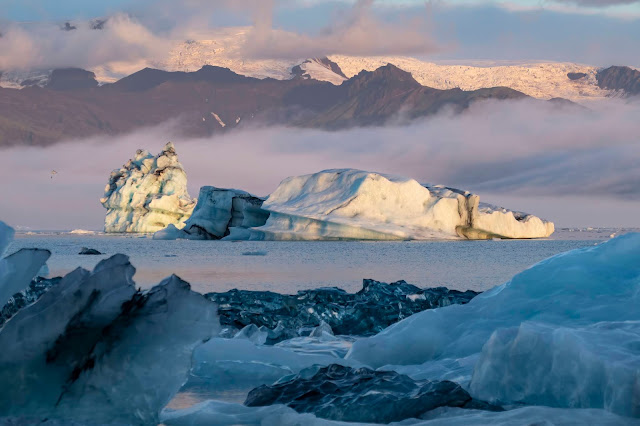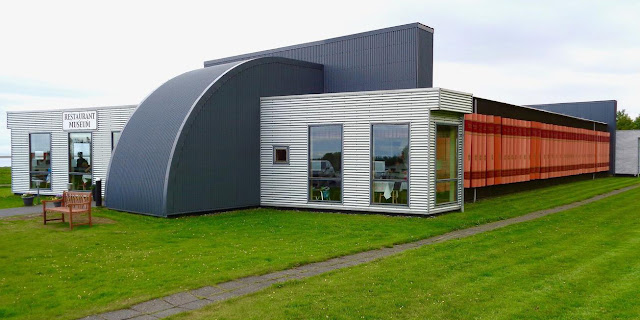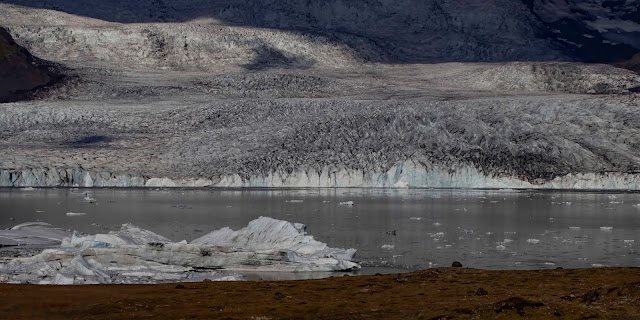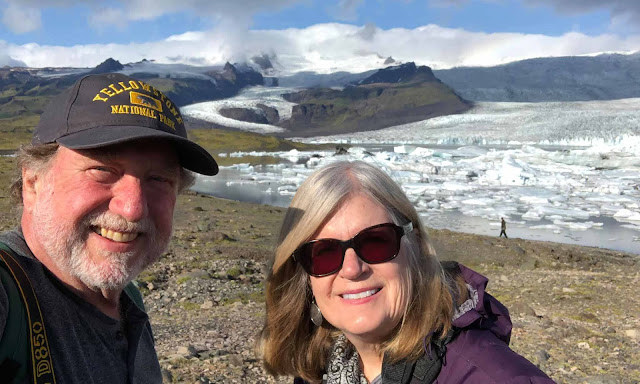 |
| We were on our way to a favorite spot |
 |
| An abandoned building on Reyðarfjörður; Bottom photo: Scott Stevens |
We were now firmly on the Hringvegur with only a few planned detours off the main road on our itinerary. The next few days, however, would be right along the Ring Road in some of the biggest tourist areas in the country.
 |
| The road never disappoints |
The weather couldn't make up its mind. Would it be foggy and cloudy?
 |
| High fog on the highway |
Or sunny?
 |
| Still a remnant of clouds lifting |
Or both?
 |
| Rainbows are common |
The morning’s drive passed around the last of the fjords we would be visiting. Here, the mountains aren’t as severe, most of the fjords are not as long as the ones to the northwest and there is more accessible shoreline. We passed farms …
 |
| A typical Icelandic farm with white buildings with red roofs |
Mountains ...
 |
| While the landscape is slightly less severe than Vestfirðir, it's still pretty dramatic |
Fjords ...
 |
| A deep, deep blue fjord |
Waterfalls …
 |
| There is a waterfall around almost every bend |
Lighthouses ...
 |
| Two perspective on Vattarnes Light; Top photo: Scott Stevens |
Some beaches with interesting greenish rocks …
 |
| The is a wide variety of rock compositions; these rocks were very green |
Lots of seabirds ...
 |
| European Golden Plovers, Ruddy Turnstones, Common Redshanks, Black-headed Gull, Dunlin |
And, as in all of Iceland, some very pretty scenery ...
 |
| Wow! Just, wow! Photo: Scott Stevens |
On the route, we stopped briefly in Höfn, which we had heard was a charming little town. It was cute, but we didn't really take many photos, except of our delicious fish and chips lunch ...
 |
| That's Höfn through the window; Photo: Scott Stevens |
... which could possibly have come from a fish farm we just passed ...
 |
| As we left the fjords, we also left the fish farms; the South Coast faces open ocean |
Jökulsárlón
But, our destination for the next two days was calling.
 |
| Jökulsárlón; Photo: Scott Stevens |
 |
| A happy man |
I have written about it before, so I won’t go into a lot of detail on its geology or history. But, I will share lots of photos.
It’s a deep lake at the base of the Breiðamerkurjökull Glacier.
 |
| Jökulsárlón in the sunlight |
 |
| Breiðamerkurjökull feeds the lagoon; Photo: Scott Stevens |
 |
| The glacier; Photo: Scott Stevens |
The Lagoon is on the southern border of Vatnajökull National Park (we visited the northern part of the Park several days earlier).
Jökulsárlón was created by the calving glacier, which now fills the pools with icebergs every day.
 |
| Several varieties of icebergs; Photo: Scott Stevens |
 |
| Icebergs waiting by the bridge for the tide |
After the icebergs escape, some go directly into the ocean, but many get stranded on the black beach that has come to be called Breiðamerkursandur (Diamond Beach).
 |
| Looking across the beach toward the glacier |
The source of the name is obvious.
 |
| The icebergs sparkle like diamonds; Photo: Scott Stevens |
 |
| These were fairly large |
... small bergs ...
 |
| The one on the left was already floating; the right was on its way out |
... and bergs being pounded from large to small by the ocean ...
 |
| It's fun to photograph the splash |
 |
| The beach was even gorgeous in the early morning fog |
Visit Strategy
In fact, the entire visit was spectacular.
I booked two nights there so that we could see the Lagoon in the morning and afternoon and so that we would have a better chance at pretty skies. That paid off.
Over the time we were there, we saw fog ...
... sunset ...
In addition to the main Lagoon, Jökulsárlón, there is another side lagoon called Fjallsárlón, which tends to have smaller icebergs, but plenty of them.
 |
| Fjallsárlón |
Fjallsárlón
Like Jökulsárlón, Fjallsárlón has a channel that carries icebergs out to the ocean under a bridge, but the bergs don't seem to pile up or strand on a beach.
 |
| Just a few fellow visitors; Photo: Scott Stevens |
Wildlife
While Iceland isn't great for wildlife (or for birds this time of year) we did have a few sightings, including a mix of Black-legged Kittiwakes, Black-backed Gulls and Common Gulls ...
... Black-headed Gulls ...
 |
| One of Iceland's most common birds |
... Black-legged kittiwakes ...
 |
| The Kittiwakes were actively fishing |
... A Parasitic Jaeger ...
Of course, we made a mistake we seem to make too often. When we left after sundown the first night, it was cloudy, so we didn’t check for aurora.
 |
| This didn't look promising for aurora |
We noticed while at Jökulsárlón that Iceland seems to making improvements at its popular tourist areas. Indeed, we were now off the unbeaten path and back to where most people who visit Iceland go. I mentioned earlier that one-lane bridges were being replaced.
 |
| The bridge over the lagoon's outlet is still one lane |
 |
| The main parking lot |
 |
| No ice problems this day |
I have seen it completely iced over, so if you go in winter, take crampons (Caty and I actually saw a woman being blown across that lot once, her smooth shoe soles skating across the ice).
This time, there was no ice, but being so close to the glacier, it was still cold.
Jackets, hats and gloves are always needed. Fortunately, the ever-present Icelandic wind was calm this time.
In addition to looking at the icebergs, we also marveled at how strong the current was as the icebergs passed under the bridge.
 |
| The first real fog bow I had seen; Photo: Scott Stevens |
 |
| The droplets must have been tiny, tiny when we were there |
Lodging and Food
While at Jökulsárlón, we stayed in a duplex cabin at the Guesthouse Gerði, which is the closest accommodation to the Lagoon. The guesthouse is situated on a big farm with several other hotels and a hostel. Caty and I had stayed at the hostel, Skyrhúsid Guest House, when we visited and Scott and I had stayed at Gerði’s hotel when we went on a tour from Reykjavik.
 |
| Our digs for two nights |
The cabin was OK, but not a secluded as we had hoped. And, because it sat in a depression on the property, it was not good for looking for aurora.
But, it was convenient.
What was NOT convenient was that the people who were staying in Cabin 1 (which was on the left) parked in our space next to Cabin 2 on the right instead of the space on the left. So, we had to park in space 1. I wondered if we stomped our feet too much when walking right by their door to our cabin.
 |
| A modest cabin with allegedly convenient parking |
As I recall, Gerði’s restaurant was so-so. While we were there, their menu wasn’t too appealing (not a fan of lamb soup), so we went to the restaurant associated with the Hali Country Hotel, the other hotel on the property. I had eaten there several times and it was as good as ever. We ended up eating there both nights.
 |
| The restaurant (which houses a small museum) looks like a giant bookshelf: Photo: Kayak.com |
Svínafellsjökull
However, I will mention one other stop. Just a little further down the coast is the Svínafellsjökull Glacier near Skaftafell National Park.
 |
| Svínafellsjökull |
Svínafellsjökull is a sub-glacier that flows from Iceland's largest glacier, Vatnajökull.
 |
| The BIG glacier |
Suðurland has many gorgeous places (I will cover more in my next post), including magnificent glaciers …
 |
| A variety of icebergs |
... and diamond beach …
 |
| A sight you don't see every day |
If you visit Iceland and have limited time, make sure you go as far as Jökulsárlón and stop to see everything along the way (if you have limited time, you will be approaching from the west rather than from the east as we did on this trip).





















No comments:
Post a Comment